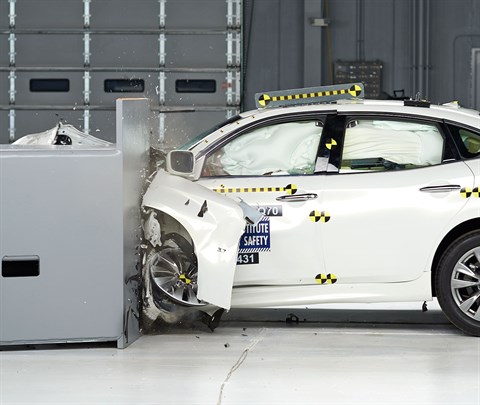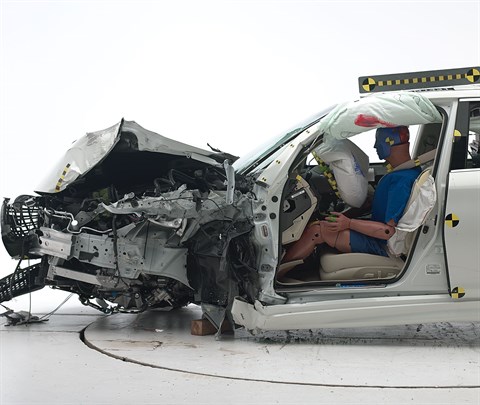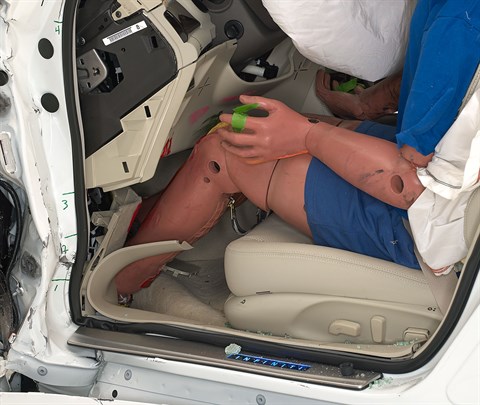Small overlap front: driver-side
Rating applies to 2014-19 models
Tested vehicle: 2014 Infiniti Q70 3.7 4-door
The Infiniti M sedan was renamed the Infiniti Q70 beginning with the 2014 model year, available with V6, V8, and hybrid V6 powertrains. Starting with 2013 M models, design changes were made to the frontal airbags and seat belts; no additional substantive changes were made with the model name change for 2014.
| Evaluation criteria | Rating |
|---|---|
| Structure and safety cage | |
| Driver injury measures | |
| Head/neck | |
| Chest | |
| Hip/thigh | |
| Lower leg/foot | |
| Driver restraints and dummy kinematics | |

Action shot taken during the small overlap frontal crash test.

The dummy's position in relation to the door frame, steering wheel, and instrument panel after the crash test indicates that the driver's survival space was maintained reasonably well.

The frontal and side curtain airbags worked well together to keep the head from coming close to any stiff structure or outside objects that could cause injury.

Except for door hinge pillar deformation and intrusion of the parking brake pedal (not visible), the driver's space was maintained reasonably well, and risk of injuries to the dummy's legs and feet was low.
Moderate overlap front: original test
Rating applies to 2014-19 models
Tested vehicle: 2013 Infiniti M37 Premium 4-door 4wd
Beginning with the 2014 model year, the Infiniti M sedan was renamed the Infiniti Q70, available with V6, V8, and hybrid V6 powertrains.
The Infiniti M sedan was redesigned for the 2011 model year and renamed the M37 and M56 at that time because the sizes of the two available engines were increased. A hybrid-electric version of the M, known as the M Hybrid, was introduced in the 2012 model year. Beginning with 2013 models, design changes were made to the frontal airbags and seat belts.
Two moderate overlap frontal tests of the M were conducted by Nissan, one of a 2011 model and the other representing a 2013 model. These cars are rated separately, except that the structure ratings for both vehicles are based on both tests. (The second car tested by Nissan was designated as a 2012 model but included the airbag and seat belt changes of the 2013 models.)
| Evaluation criteria | Rating |
|---|---|
| Overall evaluation | |
| Structure and safety cage | |
| Driver injury measures | |
| Head/neck | |
| Chest | |
| Leg/foot, left | |
| Leg/foot, right | |
| Driver restraints and dummy kinematics | |
Side: original test
Rating applies to 2014-19 models
Tested vehicle: 2013 Infiniti M56 Premium 4-door 4wd with standard front and rear head curtain airbags and standard front seat-mounted torso airbags
Beginning with the 2014 model year, the Infiniti M sedan was renamed the Infiniti Q70, available with V6, V8, and hybrid V6 powertrains.
The Infiniti M sedan was redesigned for the 2011 model year and renamed the M37 and M56 at that time because the sizes of the two available engines were increased. A hybrid-electric version of the M, known as the M Hybrid, was introduced in the 2012 model year. Beginning with 2013 models, design changes were made to the seat-mounted side torso airbags to improve occupant protection in side impact crashes.
Two side tests of the M were conducted by Nissan, one a 2011 M37x and the other a 2013 M56x. These cars are rated separately, except that the structure ratings for both vehicles are based on both tests, as are rear dummy injury and head protection ratings, because no changes were made to the rear occupant compartment.
| Evaluation criteria | Rating |
|---|---|
| Overall evaluation | |
| Structure and safety cage | |
| Driver injury measures | |
| Head/neck | |
| Torso | |
| Pelvis/leg | |
| Driver head protection | |
| Rear passenger injury measures | |
| Head/neck | |
| Torso | |
| Pelvis/leg | |
| Rear passenger head protection | |
Roof strength
Rating applies to 2014-19 models
Tested vehicle: 2011 Infiniti M37 4-door
Rating does not apply to V8 4-wheel drive models. Rating of these models is Acceptable.
| Overall evaluation | |
|---|---|
| Curb weight | 3,821 lbs |
| Peak force | 16,085 lbs |
| Strength-to-weight ratio | 4.21 |
Head restraints & seats
Seat type: Power leather seat
| Overall evaluation | |
|---|---|
| Dynamic rating | |
| Seat/head restraint geometry |
About the head restraint & seat test
Currently, IIHS tests apply only to front seats.
